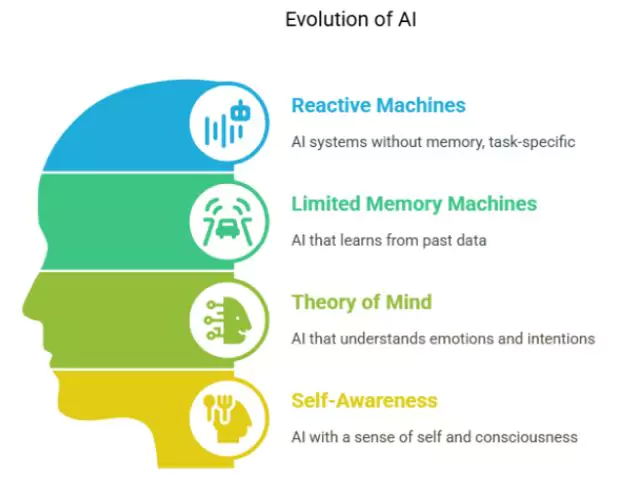The Prime Minister’s Independence Day address emphasized sovereignty, urging self-reliance in technology, defence, economy, agriculture, and citizens as guardians of autonomy, with focus on AI, cybersecurity, deep tech, and indigenous systems for national strength.
About Artificial Intelligence (AI)
- Refers: The development of computer systems that can perform tasks typically requiring human intelligence. These tasks include learning, reasoning, problem-solving, perception, speech recognition, and language understanding.
- Key Components and Techniques in AI: AI weaves its magic through five vital threads: learning, reasoning, problem-solving, perception, and language.
 Machine Learning (ML): A subset of AI, ML involves developing algorithms that allow computers to learn from data and improve performance over time without being explicitly programmed.
Machine Learning (ML): A subset of AI, ML involves developing algorithms that allow computers to learn from data and improve performance over time without being explicitly programmed.
- Types include supervised learning, unsupervised learning, and reinforcement learning.
- Deep Learning: A subfield of ML, deep learning involves neural networks with multiple layers (deep neural networks).
- Effective in image recognition and speech recognition.
- Neural Networks: Fundamental to AI and ML, especially deep learning.
- Computational models inspired by the human brain, consisting of interconnected nodes (artificial neurons) organized in layers.
- Natural Language Processing (NLP): Focuses on interaction between computers and human languages.
- Enables understanding, interpreting, and generating human-like text, crucial for chatbots and language translation.
- Computer Vision: Enables machines to interpret visual data such as images or videos.
- Applications include object recognition and image classification.
- Robotics: AI integration enables robots to perform autonomous tasks.
- Includes physical robots and software-based robots.
- Expert Systems: Computer systems designed to mimic human expert decision-making in a particular domain.
- Use rule-based systems to make decisions based on predefined rules.
- From robots aiding surgery to algorithms predicting your next song, AI’s future brims with endless possibilities. This journey requires continuous learning, ethical integration, and responsible exploration of the potential within machines that think.
- Examples:
- Google Search: Uses AI to deliver relevant query results.
- YouTube, Amazon, Netflix: Employ AI for personalized recommendations.
- Google Assistant, Bixby, Siri, Alexa: Use AI for voice recognition and responses.
- Waymo: AI-powered self-driving cars.
- ChatGPT: OpenAI language model generating human-like text and creative content.
- Bing: AI search engine with NLP, image recognition, and machine learning.
- Bard: Google chatbot using Gemini for multimodal reasoning across text, audio, images, video, and code.
- Gemini: Google’s advanced AI model, surpassing humans in Multitask Language Understanding (MMLU) and HumanEval (Python code generation).
Growth of AI Globally
- Evolution of AI Models: In 2018, the largest AI models had about 340 million parameters.
- By 2025, cutting-edge systems like ChatGPT (1.8 trillion parameters), Google Gemini (1.5 trillion), and China’s DeepSeek (240 billion) reflect exponential growth.
- Significance of Parameters: Parameters act as “knowledge units” of AI.
- They determine the model’s accuracy, versatility, and cognitive power.
- Resource Requirements: Development of frontier AI requires:
- Vast datasets for training.
- Enormous computing power (supercomputers, GPUs, quantum experiments).
- Multi-billion-dollar investments.
- Global AI Domination: Due to high entry barriers, only a few nations and corporations dominate the AI frontier.
- Concentration is largely in the US, China, and a handful of tech giants.
- Geopolitical Implications: Nations that succeed in building sovereign AI systems gain:
- Strategic leverage in digital governance.
- Greater bargaining power in trade negotiations.
- Enhanced geopolitical influence in the emerging tech order.
About Artificial Intelligence (AI) Sovereignty
- Definition: Sovereign AI refers to the ability of a nation to design, control, and deploy artificial intelligence systems independently, without excessive reliance on foreign corporations or states.
- Core Dimensions include:
- Data Sovereignty: It is ensuring that citizens’ data is stored, processed, and protected within Indian jurisdiction.
- Algorithmic Control: It means building AI models that reflect India’s socio-economic conditions, cultural values, and democratic ethos.
- Infrastructure Independence: By strengthening indigenous capacity in semiconductors, compute power, sovereign cloud, and supercomputing facilities.
- Policy Autonomy: It deals by having national control over the rules that govern AI use in defence, healthcare, finance, and governance.
Sovereignty and Aatmanirbharta in the Digital Age
- Traditional Dimension: Historically, sovereignty meant political control and territorial integrity.
- Contemporary Dimension: In today’s era, it extends to digital sovereignty, the capacity to control data flows, digital infrastructure, and algorithms shaping society.
- Aatmanirbharta in AI:
- Technological Self-Reliance:
- Requirement: Building and owning critical technologies instead of depending on imports.
- Rationale: Ensures long-term strategic autonomy in emerging technologies.
- Preventing Digital Colonialism:
- Challenge: Global tech giants may extract Indian data and dominate Indian markets.
- Response: Developing indigenous AI ecosystems to retain control over national digital resources.
- Safeguarding Constitutional Values:
- Concern: Algorithms now mediate rights, dignity, and opportunities.
- Objective: Ensure AI systems are aligned with justice, autonomy, and democratic values in the digital age.
Need for India’s Indigenous AI Capabilities
- National Security and Sovereignty: Developing indigenous AI capabilities ensures security in critical applications like defense, governance, infrastructure, cyber-defense, surveillance, border security, and autonomous weapons, protecting them from sanctions, foreign manipulation, or cyber threats.
- Example: U.S. export controls on advanced AI chips could disrupt India’s AI progress, highlighting the need for domestic alternatives to prevent foreign dependency.
- Economic Competitiveness and Growth: Building foundational AI models positions India as a global AI innovator, attracting investment and creating a robust AI ecosystem for startups and businesses.
- Significance: AI is projected to add trillions of dollars to global GDP by 2030; sovereign AI allows India to capture this value domestically rather than being a passive consumer of foreign platforms.
- Localized Solutions for Indian Needs and Social Inclusion: Sovereign AI models can cater to India’s linguistic, cultural, and socio-economic diversity, providing accurate, accessible solutions for over 22 scheduled languages and various dialects.
- Example: AI4Bharat’s IndicTrans2 project demonstrates how localized AI tools meet the unique needs of India’s multilingual population effectively and affordably.
- Fostering Talent and Innovation: Developing indigenous AI models strengthens India’s research ecosystem, nurtures talent, and makes the country self-reliant in AI, establishing it as a hub for global AI research.
- Example: IIT Madras and AI4Bharat collaborations in creating India-specific AI tools demonstrate how domestic research initiatives build talent and globally competitive solutions.
- Strategic Advantage and Global Influence: Sovereign AI models allow India to offer unique solutions internationally, reducing reliance on foreign AI and establishing India as a technology leader.
- Example: Alibaba’s success in building AI with constrained resources shows how strategic investments in localized AI can produce globally competitive solutions.
Challenges in Developing a Sovereign AI Model in India
- Hardware Deficit and Chip Manufacturing Limitations: India lacks cutting-edge semiconductor fabrication facilities, relying heavily on imported graphics processing units (GPUs) and processors, making it vulnerable to supply chain disruptions and geopolitical pressures.
- Example: Huawei’s HiSilicon chips are used globally, while India has no contracts with Taiwan Semiconductor Manufacturing Company (TSMC) for even older-generation chips, limiting domestic training of large AI models.
- High Cost of Development: Training foundation AI models requires hundreds of millions of dollars, straining India’s limited R&D budget and other priorities.
- Example: Training DeepSeek V3 cost $5.6 million per run, compared to $80 billion annual spending by global tech firms.
- Fragmented Resource Allocation: GPU clusters and computational infrastructure are spread thin across startups, academia, and public institutions, reducing efficiency for foundational model training.
- Example: Startups like AI4Bharat often rely on shared academic clusters, slowing model experimentation.
- Dependence on Proprietary and Open Models: India relies on open-source models due to the lack of sovereign alternatives, limiting true independence.
- Example: If global sanctions limit access, India may have to rely on modified open-source AI models, which could slow down innovation.
- Weak R&D Ecosystem and Public System Inefficiency: India’s public R&D system suffers from underfunding, bureaucratic rigidity, and low error tolerance, slowing trial-and-error experimentation critical for AI breakthroughs.
- Example: Large projects often face delays in approvals, unlike DeepMind or OpenAI, which have flexible high-risk budgets.
- Data Gaps and Localisation Challenges: Effective AI requires large, annotated datasets, especially in Indian languages, dialects, and local contexts.
- Examples: AI4Bharat’s IndicTrans2 addresses language translation, but broader datasets across sectors are limited.
- India’s multi-lingual population (22 official languages) makes creating comprehensive datasets expensive and time-consuming.
- Data localisation rules mandate storage in India, creating high infrastructure costs for smaller firms.
- Talent Drain: Many skilled AI researchers and engineers migrate abroad for better pay and research opportunities, weakening India’s domestic talent pool.
- Example: Indian AI graduates often join companies in the US, Europe, or China, reducing availability for sovereign AI projects.
- Regulatory Vacuum and Ethical Concerns: India lacks a comprehensive AI law, leaving ethical, accountability, and liability issues unresolved.
- Example: The Digital Personal Data Protection Act (DPDPA) 2023 and draft Digital Personal Data Protection (DPDP) Rules 2025 attempt to address data localisation and fiduciary responsibilities, but AI-specific governance is still missing.
- Energy Demands and Infrastructure Constraints: Large AI models require massive electricity and cooling infrastructure, which India currently lacks at scale.
- Examples: AI supercomputers like those under IndiaAI Mission require gigawatt-level power and advanced cooling systems.
- Smaller data centres struggle to maintain uninterrupted power and thermal management for continuous AI training.
- Subject Matter Expert (SME) Exclusion and Inequitable Access: While large corporations can absorb the costs of data localisation, infrastructure, and compliance, smaller firms often cannot, limiting inclusive innovation.
- Examples: Reliance Jio and Microsoft are building AI-ready data centres, while many Indian startups cannot afford local infrastructure for training AI models.
- Subsidies and leases help, but the scale and cost still favour large industry players over SMEs.
India’s Initiatives in AI and Data Sovereignty
- IndiaAI Mission (2024): ₹10,372 crore programme to build computer infrastructure, data platforms, and AI innovation hubs.
- Semiconductor Mission (2021): Incentivising domestic production of chips and processors.
- Digital Public Infrastructure (DPI): Platforms like Aadhaar, UPI, ONDC, and CoWIN act as scalable backbones for AI adoption.
- Start-up Ecosystem: Initiatives like BharatGPT, Sarvam AI, and Krutrim AI are developing India-centric large language models.
- Corporate Push: Companies like Tata and Reliance are investing heavily in AI infrastructure and sovereign cloud solutions.
- Skilling Initiatives: AI-related courses are being introduced in IITs, NITs, and vocational institutions to prepare a skilled workforce.
- India’s Data Sovereignty Strategy:
- Restriction Strategy: Includes data localisation mandates, bans on hostile apps (TikTok, WeChat), and VPN record-keeping rules of 2022.
- Accumulation Strategy: Building domestic data pools to train Indian AI systems.
- DPDP Act (2023): Introduced the category of Significant Data Fiduciaries (SDFs) with extra compliance requirements.
- Draft DPDP Rules (2025): Government empowered to restrict data transfers abroad, requiring explicit approval for foreign transfers.
- Infrastructure Push: New data centres and AI-ready cloud facilities being developed by Reliance, AWS, and Microsoft to ensure compute localisation.
Global Approaches
- European Union AI Act (2023): Adopts a risk-based approach, regulating high-risk AI systems more strictly.
- United States: Follows a sectoral regulatory model, prioritising innovation and market leadership.
- China: Pursues state-led AI development, with heavy investments in infrastructure and military applications.
- UNESCO AI Ethics Framework (2021): Provides principles of transparency, fairness, and accountability.
- Global AI Compact (proposed): Calls for shared AI resources and equitable distribution of technological benefits.
- Example of Global AI Sovereignty Initiatives:
-
- USA: Stargate Project ($500B AI infrastructure), Nvidia AI Nations Initiative (ecosystem & workforce development).
- France: GAIA-X (federated secure data infrastructure), Mistral-Nvidia AI Data Center.
- Germany: AI Gigafactories ($20B EU initiative, Germany central).
- UK: National AI Strategy (£1B investment in computing power & AI infrastructure).
- Singapore: AI Talent Visa Program to attract experts & build domestic ecosystem.
- South Korea: Chip Research Hub ($2.1B for advanced semiconductors for AI).
Way Forward
- Strategic Priority: Treat AI as critical infrastructure, on par with defense and energy security, ensuring long-term national sovereignty.
- Example: China’s national AI strategy treats AI as a strategic resource integrated into defense, governance, and industrial planning, guiding long-term technological leadership.
- Hardware Push: Accelerate semiconductor and chip fabrication capacity, and invest in sovereign cloud infrastructure to reduce foreign dependency.
- Example: Taiwan Semiconductor Manufacturing Company (TSMC) drives national competitiveness through domestic chip manufacturing, illustrating why sovereign hardware is critical for AI leadership.
- Legal Framework: Enact a comprehensive AI Act to balance innovation with ethics, privacy, and accountability.
- Example: The EU AI Act provides a model where AI deployment is regulated to prevent misuse while promoting responsible innovation.
- R&D Boost: Encourage high-risk, high-reward research through public-private partnerships, focusing on both foundational and applied AI.
- Example: OpenAI and Microsoft’s collaboration on GPT models demonstrates how strategic R&D partnerships accelerate AI breakthroughs with global impact.
- Talent Strategy: Create global-level opportunities within India to reverse brain drain and strengthen the domestic AI workforce.
- Example: Establish AI-focused centers of excellence in IITs and NITs to retain talent and foster innovation.
- Domain-Specific AI: Focus on AI models tailored to agriculture, healthcare, education, and local governance, leveraging India’s unique local needs.
- Example: AI4Bharat’s IndicTrans2 project addresses Indian language translation, providing linguistic diversity solutions without the massive infrastructure required for foundational models like ChatGPT.
- Others:
- Forge strategic partnerships with global tech firms for technology transfer, joint ventures.
- Encourage startups and academia to innovate within resource limitations, using cost-efficient strategies to achieve global competitiveness.
Conclusion
AI sovereignty is key to Aatmanirbhar Bharat, ensuring technological self-reliance, national security, and cultural identity. By combining indigenous AI development with selective global collaboration, India can build secure, ethical, and inclusive AI for democracy and growth.
Read More About AI in Governance
![]() 20 Aug 2025
20 Aug 2025

 Machine Learning (ML): A subset of AI, ML involves developing algorithms that allow computers to learn from data and improve performance over time without being explicitly programmed.
Machine Learning (ML): A subset of AI, ML involves developing algorithms that allow computers to learn from data and improve performance over time without being explicitly programmed.

